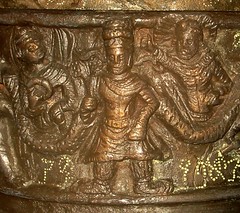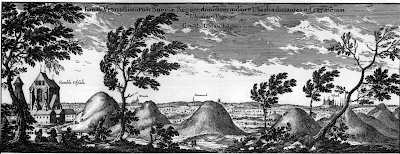 An Indus Valley Seal of what seems to be a standing Pashupati in the upper left. Photo credits to Mel Copeland: Banquet of the Gods
An Indus Valley Seal of what seems to be a standing Pashupati in the upper left. Photo credits to Mel Copeland: Banquet of the GodsA relation between Pashupati and Shiva
In ancient India there are several archaeological findings dating back to the Indus Valley Civilization (about 3.300 - 1.300 BCE) of e.g. seals that depict a yogi figure i.e. Pashupati or "proto-Shiva" (Flood, Gavin, 1996. An Introduction to Hinduism). Read more about Pashupati: Pashupati. Paśupati (Sanskrit) has been translated as ”Lord of the Cattle” or ”Lord of the animals” (references are given in the hyperlinked article).
A comment on the Wikipedia article about Pashupati, an article that needs more literature references: In the Nordic people and culture are not called Celts or Celtic, and the figure were unlikely named Cernunnos in the Nordic areas. However there might have been a close genetic and cultural relation between the ancient Celts and the ancient Nordic people.
You can read about the Harappan Civilization in a very good and illustrated article by Tarini J. Carr: Harappan period
Worshippers of Shiva or Siva is called Saiva or Shaiva (Russell, R.V., "The tribes and castes of the central provinces of India", 1916) and are followers of Shavism. Saiva or Shavia are worshipers of the God Shiva or Siva. "Shiva" is also the noun while "Shaiva" is the adjective.
According to the translation by Saivaneri site: ”The meaning of Pashupati is the essence of Saiva Samayam, Saivism, Saiva Siddhantham. Pasu means Animal. Pati means God” ( More information from this Wikimedia article ).
Saivism is old in India
In ”The Blackwell Companion to Hinduism” (Ed. Flood, Gavin, 2003) the Pashupata or Pashupati Shaivists are referred to in the Mahabharata in action that takes place in the 4 millennium BCE:( a Sanskrit Epic Pashupata Shaivism.
Pashupati Saivism is according to Flood (1996, p. 86) mentioned in texts from 400-200 BCE in Shvetashvatara Upanishad.
Read more in the following sites:
1) Development of Hinduism (search for: Saivism)
2) Saivism
3) Saivism
4) Serpent and Siva worship and mythology in Central America, Africa, and Asia (1876)
Archaeological objects from India and the Nordic Areas


 A Silver vessel, the Gudersturp Cauldron was found in Himmerland, Jutland, Denmark. It is exhibited at the National Museum (Nationalmuseet) in Copenhagen Denmark. Photo: Malene Thyssen.
A Silver vessel, the Gudersturp Cauldron was found in Himmerland, Jutland, Denmark. It is exhibited at the National Museum (Nationalmuseet) in Copenhagen Denmark. Photo: Malene Thyssen. This is an Indus Valley Seal that resembles one of the scenes at the Gudersturp Cauldron from "Nordic Iron Age" in Denmark. "Nordic Iron Age" is dated to a different period compared to e.g. "Indus Valley Iron Age" (Harappan Iron Age period that lasted 1200–300 BCE). Scandinavian Iron Age is placed to the period 500 BCE - about 800 CE.
 An Indus Valley Seal of a figure that has been interpreted as Pashupati. Photo credits to Mel Copeland: Banquet of the Gods
An Indus Valley Seal of a figure that has been interpreted as Pashupati. Photo credits to Mel Copeland: Banquet of the Gods Detail of the Gundestrup Cauldron shows an antlered figure holding a serpent in one hand, the figure is flanked by animals including a stag. Photo by Blodofox, 2008. Wikimedia Creative Commons ShareAlike.
Detail of the Gundestrup Cauldron shows an antlered figure holding a serpent in one hand, the figure is flanked by animals including a stag. Photo by Blodofox, 2008. Wikimedia Creative Commons ShareAlike. Detail of the Gundestrup cauldron that was found at Jutland in Denmark and dated to the 1st century BCE (Iron Age).
Detail of the Gundestrup cauldron that was found at Jutland in Denmark and dated to the 1st century BCE (Iron Age).There are other archaeological findings of similar antlered and horned figures in other Nordic areas. In the Oseberg ship burial mound there were found at least one carved figure with horns that seems to be part of a religious ceremony where there additionally was depicted serpent worship.
Take a look to the left of the second ancient picture (click on the picture) from the English Atlas made by Moses Pitt in the 1600's and you can see a Nordic Sami shaman depicted wearing a horned hat: Saamiblog. In the next Saamiblog link you view also see a real Sami shaman horned hat that is owned by Nordiska Museet in Stockholm, Sweden: Saamiblog: Bear rites
 Wood carved detail of a panel found in the Oseberg ship burial mound in Vestfold, Norway. Dated to 834 CE.
Wood carved detail of a panel found in the Oseberg ship burial mound in Vestfold, Norway. Dated to 834 CE. Carved panel found in the Oseberg ship burial mound in Vestfold, Norway. Dated to 834 CE.
Carved panel found in the Oseberg ship burial mound in Vestfold, Norway. Dated to 834 CE.The same type of serpent worship as in the Iron Age Nordic areas took place in the ancient kingdom of Gandhara. People of The Kushan Empire (20 - 280 CE) were serpent worshippers seen in both the art of of Gandhara and that of Mathura (e.g. Nagaraja: The Serpent King).

A detail of the Kanishka casket found near Peshawar, Pakistan. The Kansihka casket is an example of Indo-greek art. The figures is holding a garland or a serpent. Photo by PHGCOM, 2005 Wikimedia GNU. This particular casket is a copy exhibited at the British Museum. The original can be seen in this photo from where it is exhibied at the Lahore museum
 Three Headed Shiva Gandhara 2nd Century by PHGCOM, 2008. Wikimedia
Three Headed Shiva Gandhara 2nd Century by PHGCOM, 2008. Wikimedia The philosophy of Saivism or Shaivism is mentioned many times in the Śvetāśvatara Upanishad (400 - 200 BCE). Shiva or Siva is mentioned for the first time in this text from about 350 BCE, however Shiva is commonly interpreted as Rudra from the RigVeda texts from 1500 BCE. While Vishnu was the more important Sun God, Rudra was the god of storm, wind, and hunting. Rudra is the "The Archer" (Sanskrit: Śarva).
The origin of Shiva is the Himalayas where he lives with his wife Parvati and he is god of the wild mountains and forests. His vehicle is a Bull named Nandi. He is one of the three main gods with Vishnu and Devi. Attributes: Trident and snake (Northern India) and Antelope and axe (Southern India). When Shiva and Paravati is represented with their son Skanda (Kartikeya: The God of battle) the group is called Somaskanda.
“According to James Fergusson, the Nagas were not originally serpents, but serpent worshippers. Dr. C.F. Oldham is of the opinion that the Nagas claimed descent from the sun and had the hooded serpent for a totem. K.R. Subramaniam in his Origin of Shaivism mentions that the Naga is mixed with a cult of Saivism, and it is claimed that South Indian Saivism migrated to Northern India, leaving in the south its remnants in the Nagaras or Nayars. Further, the tribes of Nagas had powerful Kingdoms in different parts of India” (end of quote page 59). Culture and political history of Kashmir by Prithivi Nath Kaul Bamzai (1994). About the Nagas at page 58 – 59.
Mythology of the Nagas India, Kashmir, Pakistan, Cambodia, Nagaland, Tibet.
 Frey or Frej (means: master. Swedish: Herren) deity statue from Rällinge, Lunda in Södermanland, Southern Sweden, dated to the Viking Iron Age era. Foto av Christer Åhlin.
Frey or Frej (means: master. Swedish: Herren) deity statue from Rällinge, Lunda in Södermanland, Southern Sweden, dated to the Viking Iron Age era. Foto av Christer Åhlin. Another photo of Freyr can be seen in the following URL: Bronze Statue from Lunda Rällinge in Sweden Photo: Historiska Museet, Stockholm.
Other Nordic Myrhology names for Frey, Frej or Frö is Freyr Freyr and Frøy.
Continuity of Nordic history from Iron Age to 1800s
The Sami are ancient people of north-western Europe that have preserved parts of the old culture and religion at least until the 1800s e.g. serpent worship, tree worship. In different dialects of the Sami language spoken in Norway, Sweden, Finland and North western Russia there are words that might be related to Asian Saivism.
Sami Saiva:
Sáivu
Sáivu, sáiva, sávja (northern Sami)
Sájvva (Lule Sami)
Saajve (Southern Sami)
More about Sami religion Saiva: Saivu
For more photos, information and literature references you can read the blog posts that are hyperlinked here:
* The ancient Gods of the Sami
* Runes and serpent worship among the Sami
* Horned shamans of the Sami and bear-rites
* Pre-Christian Religion of the Sami, Shamans, Saiva
There are continuity in history from iron age and the old Sami history in southern and northern Nordic and western Russian areas.




































 A wood carved phallus to the upper left is illustrated by Scheffer in the book Lapponica (The History of Lappland) from 1674. In this book the ancient Nordic religion was described, but not in a scientific manner. The Christian priests that wanted to wipe it out described the ancient pagan Nordic religion. The pre-christian religion of the Nordic have been rewritten, redefined and made as incomprehensible as possible particularly after the Lutheran reformation that came from Germany in the early 1500s. You can read more in
A wood carved phallus to the upper left is illustrated by Scheffer in the book Lapponica (The History of Lappland) from 1674. In this book the ancient Nordic religion was described, but not in a scientific manner. The Christian priests that wanted to wipe it out described the ancient pagan Nordic religion. The pre-christian religion of the Nordic have been rewritten, redefined and made as incomprehensible as possible particularly after the Lutheran reformation that came from Germany in the early 1500s. You can read more in 
 A serpent over an Eight-Spooked Wheel ornament on a vessel found at Hedeskoga in Skåne or Scania, Sweden. It is dated to the Bronze Age. The previous blog-post mentioned the important symbols of the eight-spooked wheel and the serpent within ancient Buddhism.
A serpent over an Eight-Spooked Wheel ornament on a vessel found at Hedeskoga in Skåne or Scania, Sweden. It is dated to the Bronze Age. The previous blog-post mentioned the important symbols of the eight-spooked wheel and the serpent within ancient Buddhism. 



 The Gautama Buddha And Vajrapani, Gandhara 2nd Century. Photo by PHGCOM, 2007.
The Gautama Buddha And Vajrapani, Gandhara 2nd Century. Photo by PHGCOM, 2007.
 Nereid and Ketos, Sirkap, Gandhara., Pakistan. From Musee Guimet
Nereid and Ketos, Sirkap, Gandhara., Pakistan. From Musee Guimet
 Jörmungandr (the Midgard Serpent) gets an ox head as bait, from a 17th Century Icelandic document.
Jörmungandr (the Midgard Serpent) gets an ox head as bait, from a 17th Century Icelandic document.

